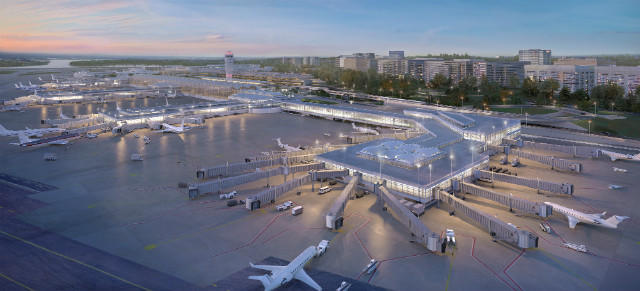American Airlines plans to grow with larger aircraft at Ronald Reagan Washington National airport once a new concourse opens in three years.
The Oneworld Alliance carrier will operate more flights from National on larger regional aircraft popular with travellers when the under construction 14-gate regional pier opens in 2021, says American president Robert Isom today.
"Today we have 14 gates that are restricted to 50-seat regional jets, when we get to the new regional terminal opening out into 2021, that will allow those 14 gates to handle up to 76 seaters," he says at the Cowen and Company Annual Global Transportation Conference.
Isom refers to the 14 remote aircraft parking positions served by buses from gate 35X, which itself is despised by travellers. While those positions are not actually "restricted" to the small planes and do handle larger regional aircraft, such operations are uncommon.
Aircraft including the Bombardier CRJ900 and Embraer 175 are more popular with customers and offer additional revenue opportunities for airlines than their smaller brethren. They have amenities that travellers have come to expect, including inflight wi-fi, extra legroom seats and a first-class cabin, while airlines benefit from the ability to monetise those same attributes.
American operates a little over a quarter of its flights from Washington National on 50-seat regional jets, FlightGlobal schedules data for September shows. It operates 45% of flights on the larger regional aircraft.
"American growing its capacity footprint at DCA – with its 13.1% pre-tax margins (along with DFW and CLT), a 5.6 [percentage] point premium over network average – is consistent with the 'Play to our strengths' theme," says Robert Mann, an industry analyst with RW Mann & Company and former airline executive.
Executives at the Fort Worth, Texas-based carrier have previously said that they plan to focus growth going forward on their most profitable hubs, namely Charlotte and Dallas/Fort Worth. Isom's comments today are the first inclusion of its Washington National hub as among those profit centres.
Washington National operator the Metropolitan Washington Airports Authority (MWAA) broke ground on the new regional concourse in March 2017. The works are part of the larger $1 billion Project Journey capital programme that also includes new consolidated security checkpoints in terminal B/C at the airport.

The new regional concourse
MWAA
The concourse will replace the remote parking positions and gate 35X, which MWAA president Jack Potter called National airport's “biggest chokepoint” last year.
"The new concourse under construction at Reagan National is designed to increase passenger comfort and convenience without adding to the number of daily flights," says MWAA.
Washington National has seen passenger traffic jump since American and US Airways merged in December 2013. JetBlue Airways, Southwest Airlines and Virgin America - since bought by Alaska Airlines - were able to add flights with the slots they acquired at the restricted airport from the deal.
Passenger traffic at National grew 17% to 23.9 million in 2017 from 2013, airport data shows. The growth allowed the close-in airport preferred by Washington DC's political class to surpass larger but distant Washington Dulles as the region's second busiest airport in 2015. Baltimore/Washington International is the busiest airport in the DC area.
American's growth plan comes as United Airlines, which operates a hub at Dulles, continues to evaluate adding more flights from the airport. Scott Kirby, president of the Chicago-based carrier, said in August that they are considering increasing the number of connecting banks - when large numbers of flights arrive and depart in a short period of time - to six from four as soon as 2019.
While growth at National may have levelled off for the time begin – passenger traffic at National was down 2.6% year-to-date through May – American's plan to fly more larger aircraft when the regional concourse opens indicates more growth is coming.
"The focus, and where growth can go, is really into the places that produce the most for American… it's Dallas/Fort Worth, it's Charlotte, it's Washington National – the most profitable parts, the most profitable hubs of American," says Isom.
Updated with statement from MWAA
Source: Cirium Dashboard



















